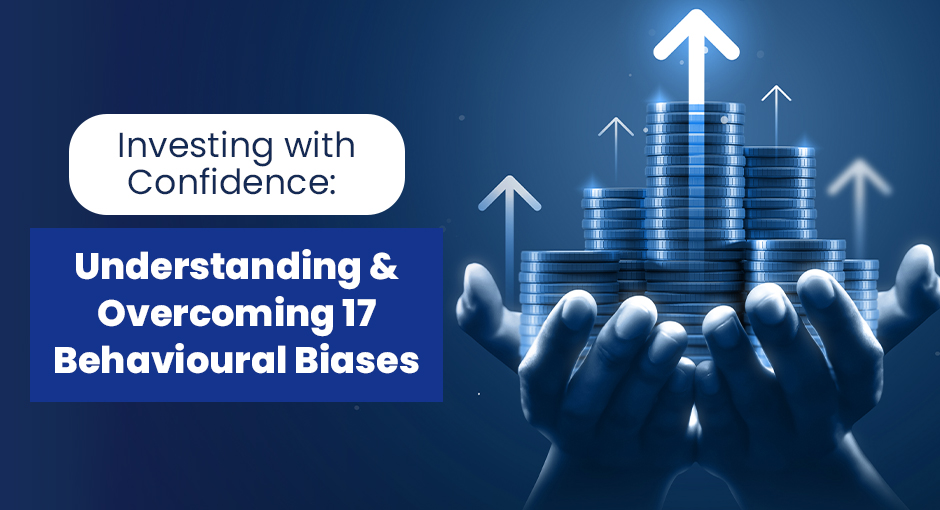
Investing with Confidence: Understanding and Overcoming 17 Behavioural Biases
Investing with Confidence: Understanding and Overcoming 17 Behavioural Biases
Introduction
Behavioural biases are psychological tendencies that can influence our decision-making process and lead to suboptimal investment decisions. These biases can be rooted in our emotions, beliefs, or cognitive shortcuts, and can affect investors of all levels of experience.
Thank you for reading this post, don't forget to subscribe!For instance, confirmation bias is an inclination to seek out information that confirms our pre-existing beliefs. Such biases can lead to poor investment decisions and lower returns. In this article, we will discuss 17 behavioural biases that can affect investment decisions. We will provide definitions, examples, and implications for investors. The biases include Mental accounting, Loss-aversion bias, Confirmation bias, Ownership bias, Gambler’s fallacy, Winner’s curse, Herd mentality/ herd behaviour bias, Anchoring bias, Projection bias, Hindsight bias, Optimism bias, Illusion of control, Overconfidence bias, Regret aversion bias, Trend-chasing bias, Availability bias and Limited Attention Span.
At Goodwill Wealth Management, we offer a range of services to help our clients achieve their investment goals, that includes, free training and webinars, and simple methods to open Demat account online. Our team of experienced professionals can help you navigate the complex world of investing and make informed decisions that align with your financial goals.
1. Mental accounting
This bias refers to the tendency to treat money differently based on its source or intended use. For instance, people may be more willing to spend money won in a lottery than money earned through hard work. This bias can lead to suboptimal investment decisions and lower returns.
2. Loss-aversion bias
This bias refers to the leaning towards feeling the pain of losses more severely than the pleasure of gains. Investors may be reluctant to sell losing investments, even if it is in their best interest because they do not want to realize a loss.
3. Confirmation bias
This bias refers to the tendency to look for information that confirms our pre-existing beliefs and ignore information that contradicts them. Investors may only seek out information that supports their investment thesis and ignore any negative news or data. This can lead to overconfidence and poor investment decisions.
4. Ownership bias
This bias refers to the tendency to place a higher value on investments that we already own, simply because we own them. Investors may be reluctant to sell an investment that has performed well in the past, even if it is no longer a good investment.
5. Gambler’s fallacy
This bias refers to the tendency to believe that past events can influence future outcomes, even when they are unrelated. For instance, investors may believe that a stock is due for a price correction simply because it has gone up for several days in a row.
6. Winner’s curse
This bias refers to the tendency to overpay for an asset in a competitive bidding process. Investors may get caught up in the excitement of winning and end up paying more than the asset is worth. This can lead to lower returns.
7. Herd mentality/ herd behaviour bias
This bias refers to the tendency to follow the crowd and make investment decisions based on what others are doing. Investors may feel more comfortable investing in a stock that is popular, even if it is overvalued. This can lead to suboptimal investment choices and lower returns.
8. Anchoring bias
This bias refers to the tendency to rely too heavily on the first piece of information received when making a decision. Investors may anchor their investment decisions on irrelevant information, such as the price they paid for a stock.
9. Projection bias
This bias refers to the tendency to assume that other people share our beliefs, values, and experiences. Investors may project their investment preferences onto others and make investment decisions based on those assumptions.
10. Hindsight bias
This bias refers to the tendency to believe that past events were more predictable than they were. Investors may look back at past events and believe that they should have seen them coming, even if they were unpredictable at the time. This can lead to overconfidence and poor investment decisions.
11. Optimism bias
This bias refers to the inclination to overvalue the likelihood of positive outcomes and underestimate the likelihood of negative outcomes. Investors may be highly optimistic about the prospects of a particular investment, leading to poor investment decisions and lower returns.
12. Illusion of control
This bias refers to the tendency to believe that we have more control over events than we actually do. Investors may believe that they can control the outcome of their investments, even when external factors are beyond their control. This can lead to overconfidence and poor investment decisions.
13. Overconfidence bias
This bias refers to the tendency to overestimate our abilities and knowledge. Investors may believe that they have an edge over other investors or the market, leading to excessive risk-taking and poor investment decisions.
14. Regret aversion bias
This bias refers to the tendency to avoid making decisions that could result in regret. Investors may be reluctant to sell an investment that has performed poorly, even if it is in their best interest because they do not want to regret their decision. This can lead to missed opportunities and lower returns.
15. Trend-chasing bias
This bias refers to the tendency to follow investment trends without fully understanding them. Investors may invest in a particular asset class or sector simply because it has performed well in the past, without considering whether it is a good investment for their portfolio.
16. Availability bias
This bias refers to the tendency to rely too heavily on information that is easily available, rather than seeking out more relevant information. Investors may make investment decisions based on recent news or events, without considering the long-term implications. This can lead to suboptimal investment strategies and lower returns.
17. Limited Attention Span
This bias refers to the tendency to focus on short-term events and ignore long-term trends. Investors may be more concerned with short-term price movements than the long-term prospects of a particular investment. This can lead to missed opportunities and lower returns.
It is important for investors to be aware of these biases and their consequences in order to make informed investment decisions. Some tips for overcoming these biases include awareness, education, research, diversification, and seeking out professional advice.
Conclusion
Behavioural biases can have a significant impact on investment decisions and returns. In this article, we have discussed 17 common behavioural biases that can affect investors of all levels of experience. These biases can be rooted in our emotions, beliefs, or cognitive shortcuts, and can lead to suboptimal investment decisions. To overcome these biases, investors should be aware of their existence and consequences.
At Goodwill Wealth Management, we understand the importance of making informed investment decisions. We offer a range of services to help our clients achieve their investment goals, including a brokerage calculator, Demat account opening etc. Our team of experienced professionals can help you navigate the complex world of investing and make informed decisions that align with your financial goals. Contact today!
To get more insights about the stock market and investment strategies, read our blogs:
To Become a great Trader, You must Avoid these 10 Mistakes
Long-Term Equity Investing: Beat the Market and Achieve Financial Freedom
What is the Difference Between Bullish and Bearish in the Stock Market?

